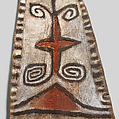Door Board (Amitung)
Not on view
The Telefolmin are one of several Highland peoples living in the Star Mountains at the source of the Sepik River in northeast New Guinea. Telefolmin artists produce no figurative sculpture, but they have a well-developed tradition of architectural carving. Among the Telefolmin, men and women live in separate dwellings, and most villages also have, or had, ceremonial houses. The entrances to all these structures were often decorated with amitung, oblong door boards with a large hole in the base through which the occupants entered and exited.
The Telefolmin state that the overall design on an amitung has no significance but that the individual elements have specific meanings. The central lozenge-shaped form on this work depicts a central feature of the human or animal body, such as the heart or navel, and the triangular forms that flank it may portray the wings of the flying fox, a large fruit bat. The spiral projections represent limbs, and the spiral motifs at the top indicate eyes. Viewing these elements in combination, some Western scholars suggest that the overall design depicts a stylized human figure.
Due to rights restrictions, this image cannot be enlarged, viewed at full screen, or downloaded.
This artwork is meant to be viewed from right to left. Scroll left to view more.









